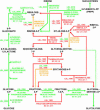Multireplicon genome architecture of Lactobacillus salivarius
- PMID: 16617113
- PMCID: PMC1436024
- DOI: 10.1073/pnas.0511060103
Multireplicon genome architecture of Lactobacillus salivarius
Abstract
Lactobacillus salivarius subsp. salivarius strain UCC118 is a bacteriocin-producing strain with probiotic characteristics. The 2.13-Mb genome was shown by sequencing to comprise a 1.83 Mb chromosome, a 242-kb megaplasmid (pMP118), and two smaller plasmids. Megaplasmids previously have not been characterized in lactic acid bacteria or intestinal lactobacilli. Annotation of the genome sequence indicated an intermediate level of auxotrophy compared with other sequenced lactobacilli. No single-copy essential genes were located on the megaplasmid. However, contingency amino acid metabolism genes and carbohydrate utilization genes, including two genes for completion of the pentose phosphate pathway, were megaplasmid encoded. The megaplasmid also harbored genes for the Abp118 bacteriocin, a bile salt hydrolase, a presumptive conjugation locus, and other genes potentially relevant for probiotic properties. Two subspecies of L. salivarius are recognized, salivarius and salicinius, and we detected megaplasmids in both subspecies by pulsed-field gel electrophoresis of sizes ranging from 100 kb to 380 kb. The discovery of megaplasmids of widely varying size in L. salivarius suggests a possible mechanism for genome expansion or contraction to adapt to different environments.
Conflict of interest statement
Conflict of interest statement: No conflicts declared.
Figures



References
-
- Klaenhammer T. R. J. Nutr. 2000;130:415S–416S. - PubMed
-
- Klaenhammer T. R., Russell W. M. Encyclopedia Food Microbiology. Vol. 2. Amsterdam: Elsevier; 2000. pp. 1151–1157.
-
- Vaughan E. E., Heilig H. G., Ben-Amor K., de Vos W. M. FEMS Microbiol. Rev. 2005;29:477–490. - PubMed
-
- Molin G., Jeppsson B., Johansson M. L., Ahrne S., Nobaek S., Stahl M., Bengmark S. J. Appl. Bacteriol. 1993;74:314–323. - PubMed
Publication types
MeSH terms
Substances
Associated data
- Actions
- Actions
LinkOut - more resources
Full Text Sources
Other Literature Sources
Molecular Biology Databases
Miscellaneous

